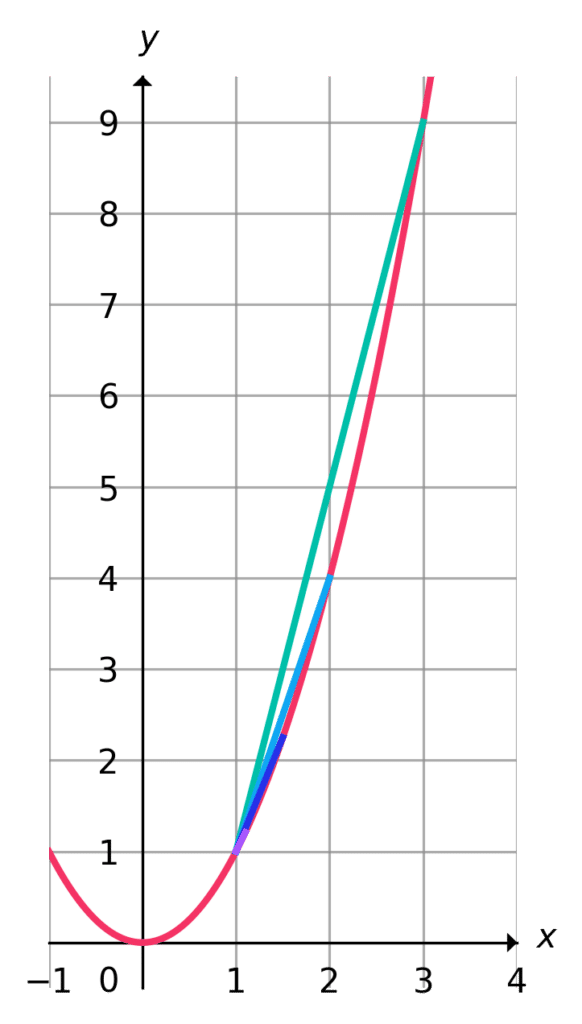Differentiation from First Principles
Differentiation from First Principles Revision
Differentiation from First Principles
The First Principles technique is something of a brute-force method for calculating a derivative – the technique explains how the idea of differentiation first came to being.


Finding Derivatives from First Principles
To differentiate from first principles, use the formula
f'(\textcolor{blue}{x}) = \lim\limits_{\textcolor{purple}{h} \to 0} \left( \dfrac{f(\textcolor{blue}{x} + \textcolor{purple}{h}) - f(\textcolor{blue}{x})}{\textcolor{purple}{h}} \right)
While this might look a little intimidating, it’s pretty easy to understand.
Think about how we describe the gradient between two points for a moment…
f'(\textcolor{blue}{x}) = \dfrac{d\textcolor{limegreen}{y}}{d\textcolor{blue}{x}} = \dfrac{\text{change in }\textcolor{limegreen}{y}}{\text{change in }\textcolor{blue}{x}}
Well, we can describe a “change in \textcolor{limegreen}{y}” as f(\textcolor{blue}{x} + \textcolor{purple}{h}) - f(\textcolor{blue}{x}) and a “change in \textcolor{blue}{x}” as the corresponding \textcolor{blue}{x} + \textcolor{purple}{h} - \textcolor{blue}{x} = \textcolor{purple}{h}
Surely then, as \textcolor{purple}{h} decreases toward 0, we find that the value of the gradient tends toward the actual value, f'(\textcolor{blue}{x}).
For example, the graph on the right shows the graph \textcolor{limegreen}{y}=\textcolor{blue}{x}^2. It also introduces four “chords”, each indicating the gradient between two points on the graph. As the colour transitions from green to purple, the value of \textcolor{purple}{h} is decreasing towards 0, for the point (\textcolor{blue}{1},\textcolor{limegreen}{1}).
h=2 gives f'(x)=4
h=1 gives f'(x)=3
h=0.5 gives f'(x)=2.5
h=0.1 gives f'(x)=2.1
Example 1: Using the First Principles Technique
Let f(\textcolor{blue}{x}) = 3\textcolor{blue}{x}^4. By differentiating from first principles and using the binomial expansion, find f'(\textcolor{blue}{x}).
[4 marks]
f'(x) = \lim\limits_{\textcolor{purple}{h} \to 0} \left( \dfrac{f(\textcolor{blue}{x} + \textcolor{purple}{h}) - f(\textcolor{blue}{x})}{\textcolor{purple}{h}} \right)
= \lim\limits_{\textcolor{purple}{h} \to 0} \left( \dfrac{3(\textcolor{blue}{x} + \textcolor{purple}{h})^4 - 3\textcolor{blue}{x}^4}{\textcolor{purple}{h}} \right)
= \lim\limits_{\textcolor{purple}{h} \to 0} \left( \dfrac{3(\textcolor{blue}{x}^{4} + 4\textcolor{blue}{x}^{3}\textcolor{purple}{h} + 6\textcolor{blue}{x}^{2}\textcolor{purple}{h}^{2} + 4\textcolor{blue}{x}\textcolor{purple}{h}^{3} + \textcolor{purple}{h}^{4}) - 3\textcolor{blue}{x}^4}{\textcolor{purple}{h}} \right)
= \lim\limits_{\textcolor{purple}{h} \to 0} \left( \dfrac{3\textcolor{blue}{x}^{4} + 12\textcolor{blue}{x}^{3}\textcolor{purple}{h} + 18\textcolor{blue}{x}^{2}\textcolor{purple}{h}^{2} + 12\textcolor{blue}{x}\textcolor{purple}{h}^{3} + 3\textcolor{purple}{h}^{4} - 3\textcolor{blue}{x}^4}{\textcolor{purple}{h}} \right)
= \lim\limits_{\textcolor{purple}{h} \to 0} \left( \dfrac{12\textcolor{blue}{x}^{3}\textcolor{purple}{h} + 18\textcolor{blue}{x}^{2}\textcolor{purple}{h}^{2} + 12\textcolor{blue}{x}\textcolor{purple}{h}^{3} + 3\textcolor{purple}{h}^{4}}{\textcolor{purple}{h}} \right)
= \lim\limits_{\textcolor{purple}{h} \to 0} \left( 12\textcolor{blue}{x}^{3} + 18\textcolor{blue}{x}^{2}\textcolor{purple}{h} + 12\textcolor{blue}{x}\textcolor{purple}{h}^{2} + 3\textcolor{purple}{h}^{3} \right)
= 12\textcolor{blue}{x}^3
Example 2: Using the First Principles Technique (Again)
Let f(\textcolor{blue}{x}) = (\textcolor{blue}{x} - 1)^2 + 4\textcolor{blue}{x} - 10. By differentiating from first principles, find f'(\textcolor{blue}{x}).
[4 marks]
f(\textcolor{blue}{x}) = (\textcolor{blue}{x} - 1)^2 + 4\textcolor{blue}{x} - 10 = \textcolor{blue}{x}^2 + 2\textcolor{blue}{x} - 9
f'(\textcolor{blue}{x}) = \lim\limits_{\textcolor{purple}{h} \to 0} \left( \dfrac{f(\textcolor{blue}{x} + \textcolor{purple}{h}) - f(\textcolor{blue}{x})}{\textcolor{purple}{h}} \right)
= \lim\limits_{\textcolor{purple}{h} \to 0} \left( \dfrac{(\textcolor{blue}{x} + \textcolor{purple}{h})^2 + 2(\textcolor{blue}{x} + \textcolor{purple}{h}) - 9 - \textcolor{blue}{x}^2 - 2\textcolor{blue}{x} + 9}{\textcolor{purple}{h}} \right)
= \lim\limits_{\textcolor{purple}{h} \to 0} \left( \dfrac{\textcolor{blue}{x}^2 + 2\textcolor{purple}{h}\textcolor{blue}{x} + \textcolor{purple}{h}^2 + 2\textcolor{blue}{x} + 2\textcolor{purple}{h} - 9 - \textcolor{blue}{x}^2 - 2\textcolor{blue}{x} + 9}{\textcolor{purple}{h}} \right)
= \lim\limits_{\textcolor{purple}{h} \to 0} \left( \dfrac{2\textcolor{purple}{h}\textcolor{blue}{x} + \textcolor{purple}{h}^2 + 2\textcolor{purple}{h}}{\textcolor{purple}{h}} \right)
= \lim\limits_{\textcolor{purple}{h} \to 0} \left( 2\textcolor{blue}{x} + \textcolor{purple}{h} + 2 \right)
= 2\textcolor{blue}{x} + 2
Differentiation from First Principles Example Questions
Question 1: For f(x) = x, prove that the gradient is fixed at 1, using first principles.
[2 marks]
= \lim\limits_{h \to 0} \left( \dfrac{x + h - x}{h} \right)
= \lim\limits_{h \to 0} \left( \dfrac{h}{h} \right) = \lim\limits_{h \to 0} 1 = 1, for all h and all x.
Question 2: Prove that, for any constant c where y = c, the gradient \bigg(\dfrac{dy}{dx}\bigg) is 0, using first principles.
[2 marks]
= \lim\limits_{h \to 0} \left( \dfrac{0}{h} \right)
= \lim\limits_{h \to 0} \left( 0 \right)
= 0
Question 3: Find the derivative of (1 + x^2)^2, from first principles.
[4 marks]
gives
f'(x) = \lim\limits_{h \to 0} \left( \dfrac{1 + 2(x + h)^2 + (x + h)^4 - 1 - 2x^2 - x^4}{h} \right)= \lim\limits_{h \to 0} \left( \dfrac{1 + 2(x^2 + 2xh + h^2) + (x^4 + 4x^{3}h + 6x^{2}h^{2} + 4xh^{3} + h^{4}) - 1 - 2x^2 - x^4}{h} \right)
= \lim\limits_{h \to 0} \left( \dfrac{1 + 2x^2 + 4xh + 2h^2 + x^4 + 4x^{3}h + 6x^{2}h^{2} + 4xh^{3} + h^{4} - 1 - 2x^2 - x^4}{h} \right)
= \lim\limits_{h \to 0} \left( \dfrac{4xh + 2h^2 + 4x^{3}h + 6x^{2}h^{2} + 4xh^{3} + h^{4}}{h} \right)
= \lim\limits_{h \to 0} \left( 4x + 2h + 4x^{3} + 6x^{2}h + 4xh^{2} + h^{3} \right)
= 4x + 4x^{3}
You May Also Like...

MME Learning Portal
Online exams, practice questions and revision videos for every GCSE level 9-1 topic! No fees, no trial period, just totally free access to the UK’s best GCSE maths revision platform.






